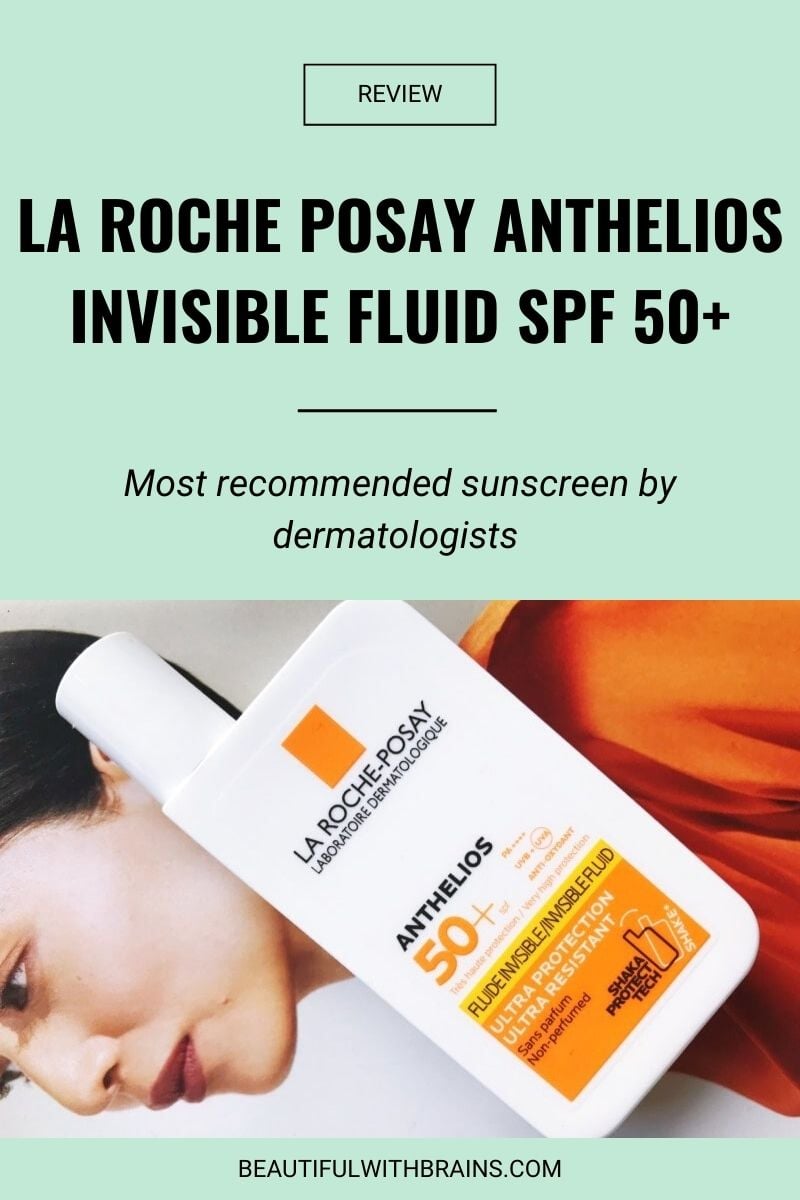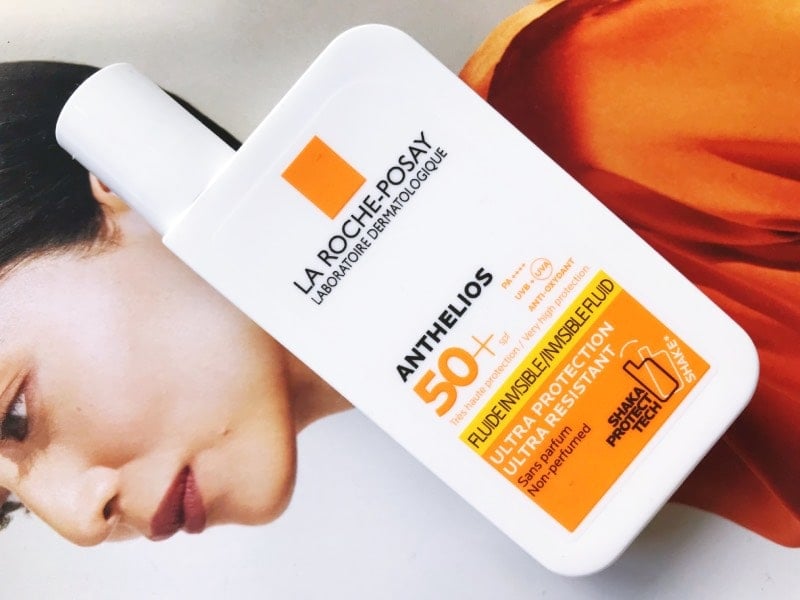
La Roche Posay Anthelios Invisible Fluid SPF 50+ is the most recommended sunscreen by dermatologists. Literally everyone I spoke to swears by it.
After testing it out, I finally get why. Incredible sun protection without the greasy, messy feel most sunscreens leave behind. What’s NOT to love?
- What’s In La Roche Posay Anthelios Invisible Fluid SPF 50+?
- The Rest Of The Formula
- Texture
- Fragrance
- How To Use It
- Performance & Personal Opinion
- Who Is This For?
- Who Is This NOT For?
- Packaging
- Does La Roche Posay Anthelios Invisible Fluid SPF 50+ Live Up To Its Claims?
- Price & Availability
- Do You Need It?
- Dupes & Alternatives
What’s In La Roche Posay Anthelios Invisible Fluid SPF 50+?
NEW GENERATION OF UV FILTERS TO PREVENT SUN DAMAGE
La Roche Posay Anthelios Invisible Fluid SPF 50+ uses a new generation of chemical filters that provides broad-spectrum protection against UV rays, premature wrinkles, and dark spots – without irritating skin:
- Ethylhexyl Salicylate: A weak UVB filter. If it were used alone, it wouldn’t even be able to protect that well from UVB rays!
- Ethylhexyl Triazone: A.k.a. Uvinul T, a photo-stable UVB filter (not available in the US yet).
- Bis-Ethylhexyloxyphenol Methoxyphenyl Triazine: A.k.a Tinosorb S, it offers excellent protection from both UVA and UVB rays.
- Butyl Methoxydibenzoylmethane: A.k.a. Avobenzone, an UVA filter that’s very unstable (ie stops working quickly when exposed to light) and is absorbed by the body. If you’re pregnant or breastfeeding, avoid.
- Terephthalylidene Dicamphor Sulfonic Acid: A.k.a, an UVA filter developed by L’Oreal. Unlike most UV filters, it’s water-soluble.
- Drometrizole Trisiloxane: Another UV filter approved for use in Europe, but not in the US.
Related: What Are The Best UV Filters?
ALCOHOL DENAT TO THIN THE TEXTURE
Alcohol Denat is a key ingredient in sunscreen. It’s a volatile carrier that helps create a thinner solution and texture.
Word on the street is that it’s terribly drying and irritating. To an extent, that’s true. Drying alcohol is very drying, both for your skin and body.
Does the same thing apply to skin when you slather alcohol on it? It depends. If alcohol’s all you’re slathering on, then yes, it will dry out your skin.
But if you use alcohol together with moisturizing ingredients, they’ll counteract its drying effects. Science confirms this. Recent studies show that alcohol isn’t as drying as we once thought.
Having said this, everyone’s skin is different. If your skin is particularly sensitive to alcohol denat and doesn’t tolerate it well, this sunscreen isn’t for you.
Related: What Does Alcohol-Free In Skincare REALLY Mean?
Is your sunscreen up to the job? Download your FREE “Sunscreen Audit” to find out if your sunscreen is both safe AND effective:
The Rest Of The Formula
NOTE: The colours indicate the effectiveness of an ingredient. It is ILLEGAL to put toxic and harmful ingredients in skincare products.
- Green: It’s effective, proven to work, and helps the product do the best possible job for your skin.
- Yellow: There’s not much proof it works (at least, yet).
- Red: What is this doing here?!
- Aqua/Water: The base of this (and most) skincare products.
- Diisopropyl Sebacate: It’s used in sunscreens for two reasons. One: it helps to create high SPF formulas with smaller concentrations of UV filters. This matters because the higher the concentrations of UV filters, the thicker and more unpleasant the formula is. Two: it helps create elegant formulas that spread easily on the skin, absorb quickly, and leave no (or at least, very little) greasy residue behind.
- Silica: This common mineral has several functions. It aborbs oil and sweat so sunscreen lasts longer; helps the formula spread easily and better adhere to your face; and it improves the distribution of pigments in cosmetics.
- Isopropyl Myristate: Super moisturising, it also helps formulations high in oil feels silky rather than greasy. Unfortunately, it’s comedogenic and can aggravate acne in oily skin. I usually break up when used this ingredient although, that didn’t happen this time. Kudos to La Roche Posay for it!
- Glycerin: An humectant that draws water from the air into your skin, helping it stay softer, suppler, and hydrated for longer.
- C12-22 Alkyl Acrylate/Hydroxyethylacrylate Copolymer: It improves the stability of the formula and it shelf life.
- Propanediol: It makes skin softer and smoother. It’s also used as a preservative to make the product last longer.
- Perlite: A naturally derived mineral that helps absorb moisture.
- Tocopherol: A powerful antioxidant that doubles up as preservative to help the formula last longer.
- Caprylic/Capric Triglyceride Acrylates/C10-30 Alkyl Acrylate Crosspolymer: It helps to stabilise emulsions.
- Caprylyl Glycol: It has moisturising and anti-microbial properties. It makes your skin softer and kills bacteria that may contaminate your sunscreen.
- Hydroxyethylcellulose: A water-soluble polymer derived from cellulose, it improves the texture and feel of the sunscreen. It doesn’t have any benefits for skin itself, but without this here, the formula wouldn’t be so pleasant to use.
- Triethanolamine: It prevents the watery and oily parts of the formula from separating.
- Trisodium Ethylenediamine Disuccinate: It binds and deactivates certain metal ions found in water that can compromise the effectiveness of the formula.
Texture
This sunscreen has one of the best textures I’ve come across. It’s lightweight – to the point of being runny. It sinks into your skin immediately, drying out to a semi-matte finish. Most importantly, it doesn’t leave any greasy residue behind. Phew!
Fragrance
This sunscreen is fragrance-free. If you’re a regular here, you know that I love fragrance-free formulas. Why? Fragrance is one of the most irritating ingredients in skincare – especially if you have sensitive skin. And, it has NO benefits for skin. It only makes the product smell good. I’ll take a sunscreen that doesn’t have much of a smell over an irritating one every day of the week – wouldn’t you?
How To Use It
Sunscreen is ALWAYS the last step of your skincare routine in the morning. Apply it generously on all exposed areas of skin (at least 1/3 of a teaspoon for face and neck). Reapply as needed during the day (in the summer, as often as every couple of hours).
Performance & Personal Opinion
La Roche Posay Anthelios Invisible Fluid SPF 50+ is really as invisible as the name suggests. It’s so runny, it sinks in immediately, leaving no tell-tale white cast or greasy residue behind. You literally can’t tell you have sunscreen on – but you do.
It also makes a good base for makeup. Just wait around 15-20 minutes for it to settle before you apply foundation or you may displace some of the sunscreen and compromise protection.
It does a great job at protecting your skin from UV harm – without irritating your skin or stinging your eyes.
If only all sunscreens were such a pleasure to use!

Who Is This For?
It’s suitable for all skin types, unless you’re allergic to one of the ingredients.
Who Is This NOT For?
- If you have dry skin, you can still use it, but you need moisturiser underneath.
- If your skin is sensitive to alcohol, this isn’t for you.
Packaging
The sunscreen comes in a tiny white bottle with a pointed applicator that ensures not a drop of the runny texture gets wasted. Plus, the small size makes it easy to carry it everywhere with you for on-the-go touch-ups.
My only pet peeve? Sunscreen is the only product you need to apply generously. Why don’t brands make bigger bottles that last us a lot longer?!
Does La Roche Posay Anthelios Invisible Fluid SPF 50+ Live Up To Its Claims?
| CLAIM | TRUE? |
|---|---|
| A very high protection, broad-spectrum (PPD 46, SPF 50+) comfortable fluid formula that is ultra water, sweat, and sand resistant. | True. |
| This non-greasy cream does not leave white marks and does not migrate. | True. |
Price & Availability
£18.00 at Feel Unique and Look Fantastic
Do You Need It?
Let’s put it this way: if you’re looking for an invisible, non-greasy, non-stinging, sunscreen that provides broad spectrum protection even in the hottest summer weather, this is it. Do you need that?
Dupes & Alternatives
Ingredients
Aqua/Water, Alcohol Denat, Diisopropyl Sebacate, Silica, Isopropyl Myristate, Ethylhexyl Salicylate, Ethylhexyl Triazone, Bis-Ethylhexyloxyphenol Methoxyphenyl Triazine, Butyl Methoxydibenzoylmethane, Glycerin, C12-22 Alkyl Acrylate/Hydroxyethylacrylate Copolymer, Propanediol, Drometrizole Trisiloxane, Perlite, Tocopherol, Caprylic/Capric Triglyceride Acrylates/C10-30 Alkyl Acrylate Crosspolymer, Caprylyl Glycol, Hydroxyethylcellulose, Terephthalylidene Dicamphor Sulfonic Acid, Triethanolamine, Trisodium Ethylenediamine Disuccinate

